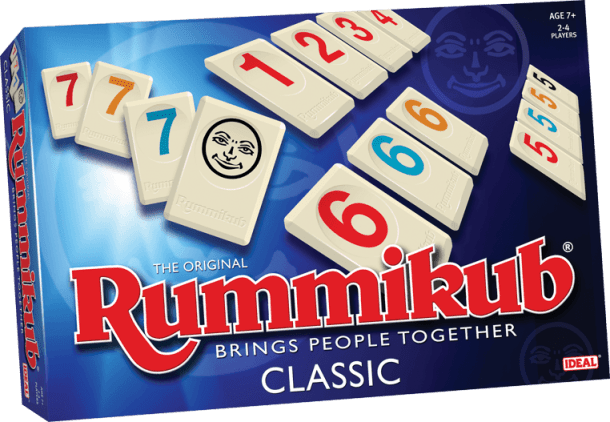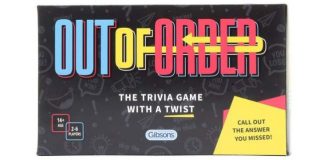We love playing board and tabletop games in our house. Not only are they an excellent way of social interaction between all the members of the family no matter what their age, but they are fun and entertaining. Some are challenging, some help develop language skills, whilst others develop thinking and strategy skills, like the object of this review – Rummikub Classic from John Adams / Ideal Games.
With the nights getting darker earlier, much colder and COVID-19 restrictions of various degrees still in place around the country staying in has never been more important, so finding a variety of in-home entertainment is a must and board games fit that scenario quite nicely.
If you haven’t already played, or heard of, Rummikub before (it was invented in the 1940s, becoming increasingly popular in the 1970s and has been around in various versions since), it is a tile-based game combining elements of mahjong and rummy. For those of you that have never seen it before, it looks similar to Scrabble but has numbers in place of letters and doesn’t have a board. The idea of the game is to get rid of all your tiles by building number groups or runs. It sounds very easy to play, but don’t be fooled, it takes a bit of brain power and cunning strategy to win.
Rummikub Classic is a family game for 2-4 players, aged 7 years and upwards. As a family of four with the youngest being 8 years old we were all looking forward to playing it as none of us had ever played it before.
The box contains:
- 106 tiles (104 numbered; 8 sets 1-13 in 4 colours; black, blue, red and yellow, 2 Jokers)
- 4 racks and rack holders
- Instructions
To start with I would really recommend reading through the rules with all the players and playing a few practice rounds to grasp the concept (if you have played the card game Rummy before you will have no issues understanding Rummikub or with playing it).
Before play commences, each player is given 14 tiles to place on their rack. Remaining tiles are placed facedown on the table in-between the players.
Once each player has their tiles arranged on their rack and the remaining tiles are positioned on the table, each player picks a tile from the array of tiles on the table and the player with the highest number goes first. Simple so far and now let the game begin.
The starting player has to lay down a group or run on the table. A group is a set of 3 or 4 tiles of the same number in different colours (but you can’t have 2 of the same colour). A run is a set of 3 or 4 consecutive number tiles in the same colour (i.e. 1, 2, 3, 4). Again this is fairly simple but on the first go the tiles placed down must have a total value equal to or exceeding 30 points (adding up all the numbers placed will give you your points total). If the player is unsuccessful a new tile must be taken from the pile in the middle of the table and that players turn ends. The next player then has to lay 30 points etc…
When each player has had a turn, going forward each player on their turn must lay at least 1 tile from their rack, either adding a new group or run or manipulating one that has already laid (i.e. adding a red 4 to a sequence of red 1, 2, 3 already on the table). If a player can’t place a tile they must take one from the pile and add it to their rack.
The game continues in this way until one player has laid all their tiles on the table and called out ”Rummikub”. If you are playing more than one match, the losers add up the values of their remaining tiles and the total of all players is given to the winner as a positive score, while each loser receives a minus score to the value of their own remaining tiles. After a few games, the player with the overall highest number of points is the winner.
Overall, once the rules have been figured out and a few games have been played to completely grasp the concept, Rummikub is a great game of thinking, strategy combined with a small helping of luck. We found that the instructions do take a bit of figuring out to understand the gameplay, especially for the youngest players so we would recommend watching some Youtube videos (as we did) to see gameplay in action and how the game works.
We did find that the start of the game when building up sets or groups can be a bit slow, but after a few have been created it does get faster and much more interesting. And the more people playing, the better it is. Having a time limit of 1 minute per turn is a great rule as waiting for another player to go through all the permutations in their head before taking their turn can be a bit tedious and would make the other players lose interest.
Whilst the game is for 7 years upwards, the rules do need a bit of explaining to the younger players and for the first few games we played as teams so that the children could see how the game worked whilst still being able to join in.
Once we got the hang of the rules we all loved playing Rummikub. It is a fun game that gets you thinking and trying to outsmart the other players. It may be more suited to older children and adults than 7 and 8 years olds, but will definitely keep the family entertained at home during any lockdown or those cold winter nights.
Our only small niggle with the game is that when storing the tiles they are just placed loose back in the box and do bounce around everywhere when the box is moved (we fear losing some if the box is dropped). A storage bag for the tiles so that they could go neatly back in the box would be ideal (we have decided to use a plastic zipper sandwich-type bag to store our tiles in now).
A fun and challenging game for all the family that can also be played without the kids, and no screen involved!
Rating: 4.5/5
RRP: £24.99
Available to buy from Amazon here.






